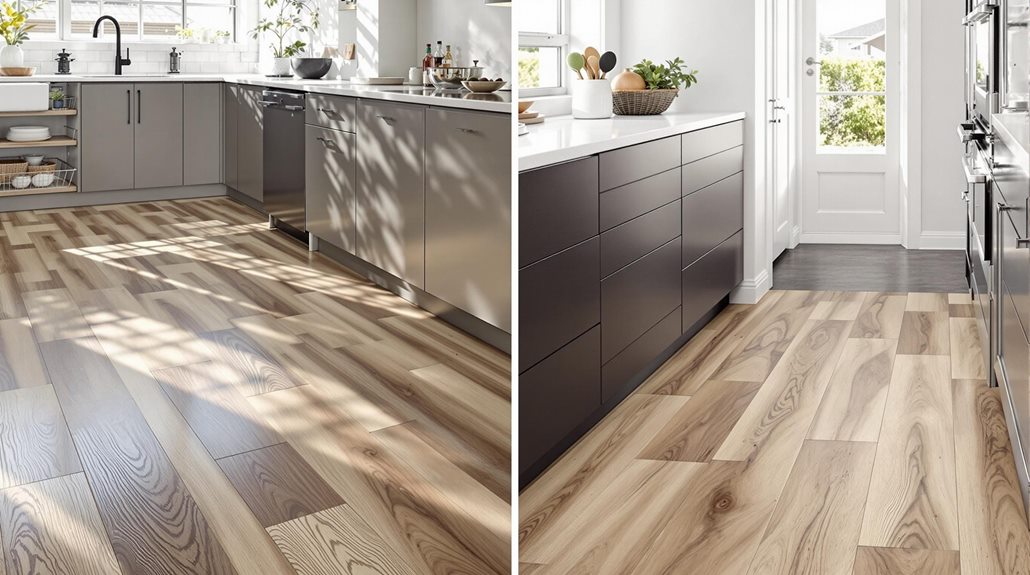Where Should I Put a TV in My Kitchen?
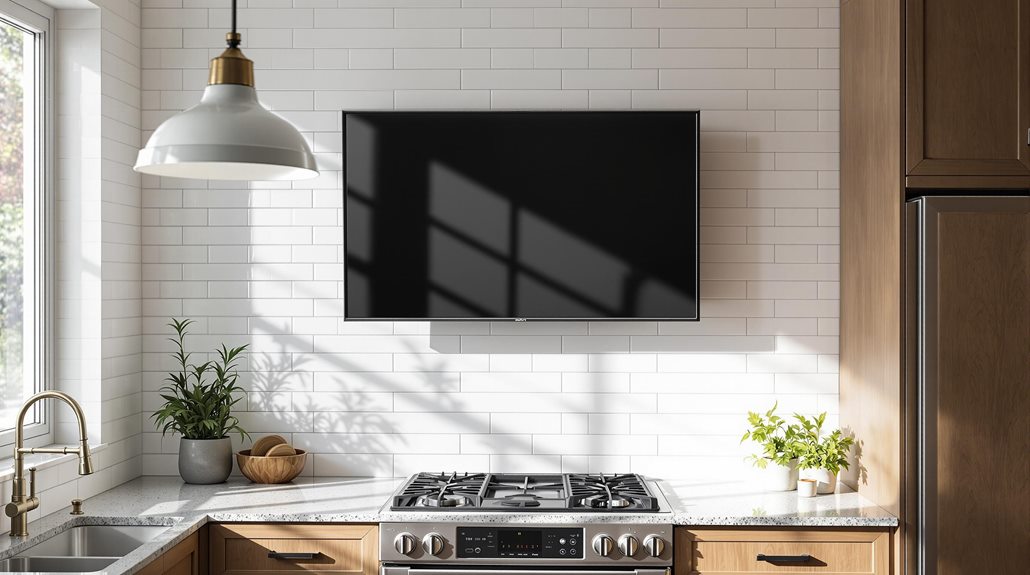
Your kitchen TV placement should prioritize both safety and viewing comfort while maintaining the room's functionality. Consider mounting your TV on a wall that's perpendicular to windows to minimize glare, and keep it away from water sources and cooking areas. For smaller kitchens, opt for a 24-inch screen with a flip-down mount or cabinet integration to save space. You'll want to position the screen at eye level, roughly 5-9 feet from common viewing areas like the dining space or prep counter. Proper mounting height and viewing distance will prevent neck strain and create an ideal entertainment setup. The right placement can alter your kitchen into a perfectly balanced cooking and viewing space.
Smart TV Mounting Options
When it comes to mounting a TV in your kitchen, several versatile options can maximize both viewing comfort and space efficiency. To make the most of your space, you'll find that wall mounted solutions offer flexibility while keeping counter spaces clear.
Articulating mounts are ideal if you want to extend your TV behind a kitchen cabinet or into view when needed. These mounts let you adjust the screen's position and angle, ensuring perfect visibility whether you're chopping vegetables or sitting at the breakfast bar. For kitchens with bright windows, tilting mounts help reduce glare while maintaining a sleek profile against the wall.
If your kitchen serves multiple purposes, consider a swiveling mount that lets you rotate the TV to face different areas. A pull-down mount can be particularly useful when your TV's mounted higher up, allowing you to bring the screen to eye level while cooking. For ultimate convenience, motorized mounts offer hands-free adjustment with the press of a button - perfect when you're handling food or cleaning.
The key is choosing a mount that fits your kitchen's layout and your viewing habits, ensuring your TV enhances rather than intrudes upon your kitchen space.
Hidden Storage Solutions
Beyond mounting options, smart storage solutions can make your TV virtually disappear when not in use. Installing pocket doors in your wall cabinets creates a seamless look while concealing your screen behind refined panels that slide away when you're ready to watch. This approach maintains your kitchen's clean aesthetic while keeping entertainment readily accessible.
Cabinet integration offers another sophisticated solution, allowing you to build your TV directly into your existing cabinetry. You'll find flip-down TV mounts particularly useful when you want to hide your screen behind a decorative valance or cabinet panel, revealing it only when needed. For kitchens where space is at a premium, corner-mounted installations provide discrete placement that minimizes visual disruption.
If you prefer more flexibility, consider wall-mounted TVs with articulating arms. These mounts let you pull the screen out when viewing and push it flat against the wall when not in use. This option works well with existing cabinetry and doesn't require extensive modifications to your kitchen's layout. Each of these hidden storage approaches helps maintain your kitchen's primary function while accommodating modern entertainment needs.
Optimal Viewing Distance Guidelines
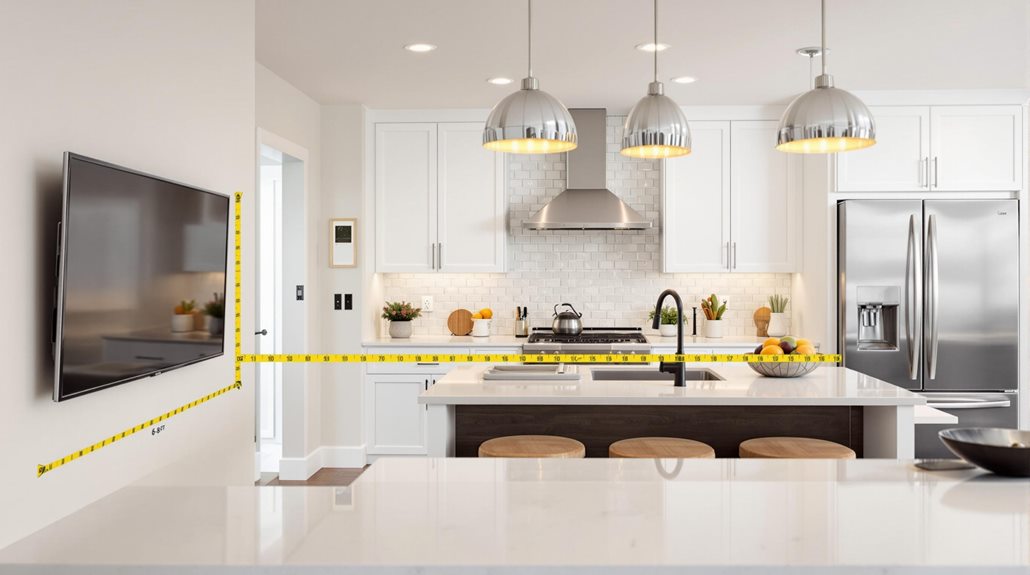
Proper spacing plays a crucial role in creating a comfortable TV viewing experience in your kitchen. When positioning your TV screen, you'll need to consider the ideal viewing distance based on its size to prevent eye strain and maximize enjoyment while cooking or dining.
For a small kitchen where space is limited, a 24-inch TV might be your best option, requiring approximately 5 feet of viewing distance. If you have more room to work with, a 32-inch TV needs about 9 feet between you and the screen. Remember to mount the TV at eye level for the most comfortable viewing angle, especially if you'll be watching while seated at a counter or kitchen island.
Consider your typical cooking and dining areas when determining TV placement. If you're usually preparing meals at the counter, ensure the viewing distance aligns with these guidelines from that spot. For instance, if your prep area is 6 feet from the proposed TV location, a 24-inch screen would work well, while a 32-inch might be too large for comfortable viewing. This careful planning will help create an optimal viewing setup that enhances your kitchen's functionality without causing discomfort.
Kitchen Design Integration Tips
Successful kitchen TV installations require thoughtful design integration to maintain both functionality and style. When planning your kitchen TV layout, you'll want to coordinate the cabinet design and placement to create a cohesive look that doesn't disrupt your kitchen's aesthetic appeal.
Wall-mounted TVs offer the most versatile solution for kitchen spaces, allowing you to maximize your counter space while achieving ideal viewing angles. You'll need to carefully consider the TV's position in relation to windows and other light sources to prevent glare issues that could affect your viewing experience. If you're opting for open shelving, design a dedicated central space that can accommodate your kitchen TV and related electronics like DVD players or sound systems.
When integrating your TV into kitchen cabinetry, guarantee the design accounts for proper ventilation and cable management. Consider installing adjustable mounting brackets that let you modify the viewing angle based on different cooking or dining positions. Remember that LCD screens have specific viewing angle limitations, so position your TV where you'll most commonly watch it. By thoughtfully incorporating these design elements, you'll create a seamless blend between your kitchen's functionality and entertainment capabilities.
Safety and Protection Measures
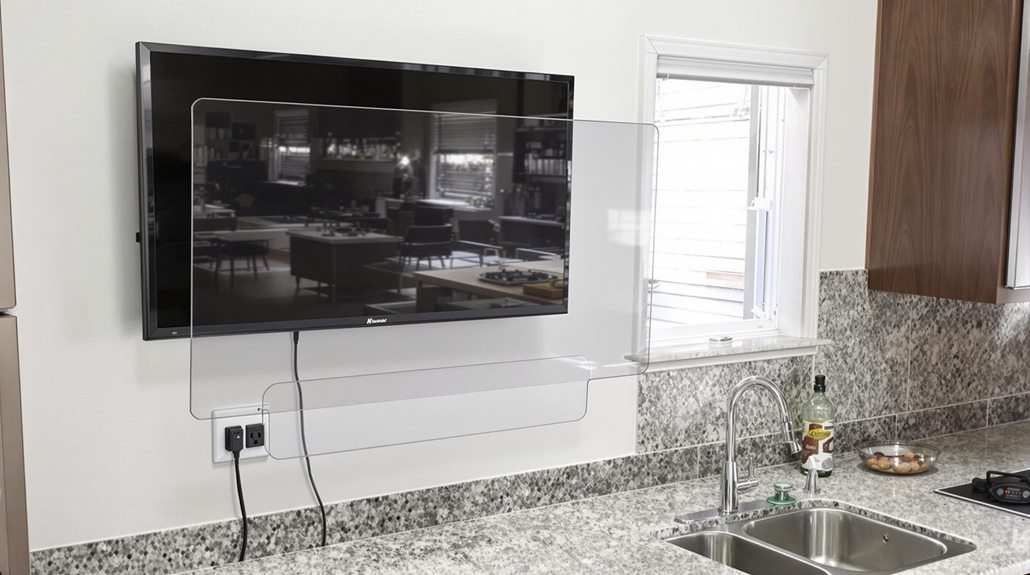
Installing a TV in your kitchen requires more than just aesthetic considerations - you'll need to prioritize safety and protection measures to safeguard your investment lasts. When mounting your flat screen on the wall, guarantee it's positioned well away from water sources like sinks and faucets to prevent damage from splashes during dishwashing or food preparation.
Select a TV mount or cabinet that offers protection against kitchen-specific hazards. Your flat screen will be exposed to cooking grease, steam, and other airborne contaminants that aren't typically present in other rooms. Consider investing in a television specifically designed with protective coatings or materials that resist these harmful elements.
Don't overlook proper ventilation when installing your kitchen TV. If you're placing it inside a cabinet, ensure there's adequate airflow to prevent overheating. You'll also need to secure both the TV and its cables properly to avoid accidents during busy cooking sessions. Mount all cables away from cooking areas and secure them tightly to prevent them from dangling or creating tripping hazards. If you're using a cabinet-mounted solution, make sure it's firmly anchored to support your flat screen's weight.
Space-Saving TV Placement Ideas
When space comes at a premium in your kitchen, clever TV placement becomes essential for maintaining functionality while adding prized entertainment value. For kitchens under 90 square feet, you'll want to put the TV in a spot that's viewable from up to 9 feet away, and a 24-inch small TV is your best bet for maintaining proportion.
To maximize your kitchen's workspace, consider installing a flip-down TV that tucks neatly into your upper cabinets when not in use. This solution keeps your TV protected while freeing up cherished counter and wall space. If you're planning a kitchen renovation, you can integrate your TV directly into your cabinetry for a sleek, modern appearance that won't disrupt your kitchen's flow.
Wall-mounting your TV with an adjustable bracket offers another space-saving solution. You can pivot and swivel the screen to accommodate different viewing angles as you move around your kitchen. Just be sure to position it away from windows and bright light sources to prevent glare. By choosing the right mounting solution and location, you'll create an entertainment space that doesn't compromise your kitchen's functionality.
Light Management Strategies
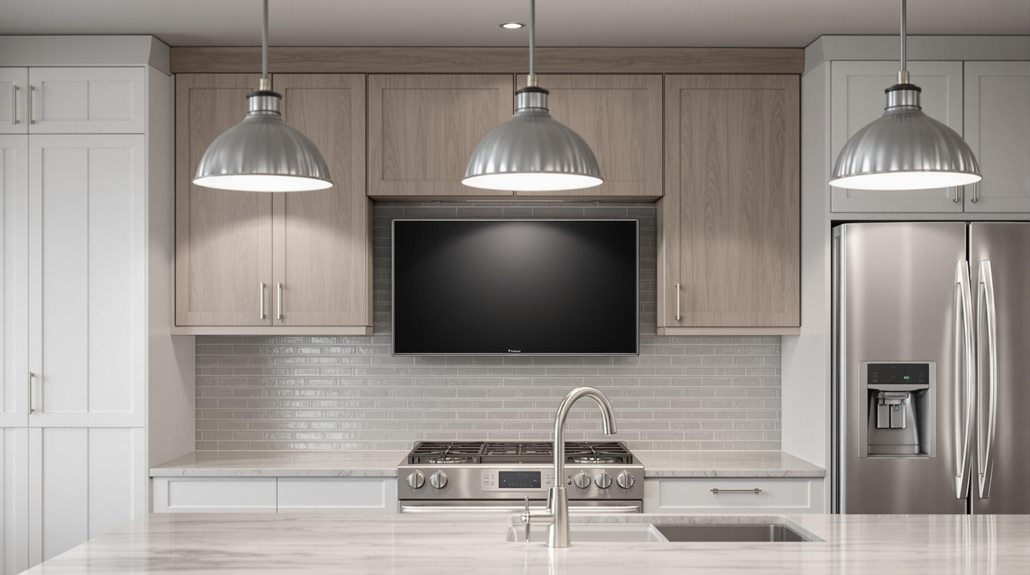
Light plays a key role in your kitchen TV viewing experience, making smart illumination strategies necessary for ideal screen visibility. When choosing your TV's placement, you'll want to avoid positioning it directly opposite windows or bright light fixtures that can create annoying glare on the screen. Instead, mount or place your TV perpendicular to natural light sources to minimize reflections.
To enhance your viewing comfort, you'll need to implement strategic lighting solutions around your kitchen TV area. Install dimmers on your overhead lights so you can adjust brightness levels throughout the day and evening. You can also add task lighting or under-cabinet lights that won't interfere with the screen while still providing enough illumination for kitchen activities. Consider incorporating soft, indirect lighting options like wall sconces or LED strips that create a balanced ambient environment without causing harsh reflections.
Remember to assess your kitchen's lighting conditions during different times of day before finalizing your TV placement. If you can't avoid some natural light exposure, you might want to invest in anti-glare screen protectors or adjustable window treatments to maintain favorable viewing conditions.

